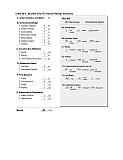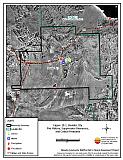19.0 Boulder City
19.1 Risk and Hazard Assessment
The Community of Boulder City is located southeast of Las Vegas in southeastern Clark County. The hazard assessment resulted in classifying Boulder City in the Low Hazard category (30 points). The low rating is primarily attributed to good access and signage, adequate defensible space, and the use of fire resistant building materials. A summary of the conditions that contributed to the hazard rating for Boulder City is included in Table 19-3 at the end of this section. The Boulder City community boundary is shown in Figure 19-1.
19.1.1 Community Design
The area surrounding Boulder City is a classic wildland-urban interface condition, with a clear line of demarcation between building structures and wildland fuels. There are several clusters of homes on the outskirts of town, but wildland vegetation typically does not continue into the development areas. Most residences were on parcels of less than one acre in size.
Access: Boulder City is accessed via US Highway 93, which becomes Veterans Blvd. in town. The highway is a paved two-lane road. All secondary roads were paved and provide adequate room for fire suppression equipment to maneuver.
Signage: Street signs are visible on all of the roads in the community. Residential addresses are visible on about 88 percent of the homes in the community.
Utilities: Utilities are both above and below ground. Utility rights-of-way were well maintained and pose a low ignition risk.
19.1.2 Construction Materials
All of the homes in the interface are built with non-combustible roofing and siding materials.
Twelve percent of the homes in the community have unenclosed balconies, porches, decks or other architectural features that create drafts and provide areas where sparks and embers can be trapped, smolder, ignite, and rapidly spread fire to the home.
19.1.3 Defensible Space
Eighty-two percent of the homes have landscaping that meets the minimum requirement for defensible space to reduce the risk of property damage or loss of a home during a wildfire.
19.1.4 Suppression Capabilities
Wildfire Protection Resources
The Boulder City Fire Department (BCFD) is staffed by eighteen career firefighters and 24 paid on-call firefighters. The fire department was established in 1959 with the incorporation of Boulder City and currently serves a population of 15,000 people over a service area of 206 square miles. In the event of a wildland fire, County resources could be called in through mutual aid agreements and the Clark County Fire Alarm Office. Suppression resources located at Nellis Air Force Base, the Clark County Fire Department, and the Henderson Fire Department provide mutual aid through pre-existing agreements.
| Type of Resource | Amount of Equipment | Cooperating Partner (Resource Location) |
|---|---|---|
| Type 3 Engine.4 X4 Rescue/Squad Advanced Life Support (ALS) Rescue |
1 1 |
Boulder City Fire Department |
| Type 3 Brush Engine Type 6 Brush Patrol Engine |
1 1 |
National Park Service (Boulder City) |
| Source: Steve McClintock, Kurt Leavitt, Mark Blankensop, pers. comm. March 2004. K. Oliver, pers. comm. 12 Oct 2004 | ||
Mutual aid can be requested from the US Forest Service, the National Park Service, and the Bureau of Land Management through the Las Vegas Interagency Communications Center. The Nevada Division of Forestry also provides mutual aid dispatched from the Sierra Front Interagency Dispatch Center in Minden, Nevada, which locates the nearest available fire suppression resource according to incident command and computer aided dispatch protocols. It is important to note that these resources can be assigned to other emergency incidents during the fire season.
Water Sources and Infrastructure
Water available for fire suppression in Boulder City includes fire hydrants within 500 feet of structures with a minimum of 500 gpm flow capacity and four water storage tanks totaling 19.5 million gallons. The water system operates by gravity.
Fire Protection Personnel Qualifications
All firefighters are trained to the State of Nevada Fire Marshal Firefighter II qualifications, in compliance with NFPA standards.
Work Load
The Boulder City Fire Department responded to 1,389 emergency medical calls, no wildland brush fire calls, and 594 other calls in 2003.
Financial Support
Financial support for the Boulder City Fire Department comes from the Town General Fund.
Community Preparedness
Boulder City has several plans for community preparedness. All plans are updated annually. These plans include:
- Emergency Plan,
- Pre-Attack Plan,
- Disaster Plan, and
- Emergency Evacuation Plan.
The City Manager, Fire Chief, Police Chief, and Public Works Director are all authorized to activate the Emergency Evacuation Plan.
The Boulder City Fire Department reviews development plans to ensure compliance with the 1997 Uniform Fire Code Standards (with amendments).
19.1.5 Factors Affecting Fire Behavior
The vegetative community in the Boulder City area is Mojave Desert scrub dominated by creosote bush, cholla cactus, and Mojave prickly pear cactus. Tamarisk trees dominate the fuels in the drainages. In general, fuels are light and the fuel hazard in the interface area was considered low.
19.1.6 Fire Behavior Worst-case Scenario
Boulder City is located in the hills between Henderson and Lake Mead. In years with above average precipitation, annual grass production can create a fine continuous fuel bed that is susceptible to ignitions and capable of supporting a fast moving fire that can spread to the shrub layer. The typical afternoon winds from the south to southwest could push a grass fire through the canyons toward the community. However, paved streets and block walls protect most structures from the threat of wildfire.
19.1.7 Ignition Risk Assessment
Boulder City has a low ignition risk rating. There is no significant wildfire history reported for the lands surrounding the community, and the ignition history shows very few incidents.
19.2 Risk and Hazard Reduction Recommendations
The hazard reduction recommendations for Boulder City focus on weed control and firefighter training and equipment.
19.2.1 Defensible Space Treatments
Defensible space treatments are an essential first line of defense for residential structures. The goal of the treatments is to significantly reduce or remove flammable vegetation within a prescribed distance from structures. (Refer to Appendix E for the recommended defensible space area). Defensible space reduces the fire intensity and improves firefighter and homeowner chances for successfully defending a structure against oncoming wildfire.
Property Owners
- In years of above normal precipitation, mow and remove annual grasses and weeds along roadways, fences, and buildings.
- Clean up yards annually prevent dried weeds from accumulating against buildings, vehicles, and fences.
19.2.2 Wildland Fire Training and Equipment
Boulder City Fire Department
- Provide all firefighters with basic wildland fire training and equipment as described in the National Wildfire Coordinating Group (NWCG) Wildland and Prescribed Fire Qualification System Guide 310-1. Provide annual wildland firefighting refresher training and fire shelter training.
19.3 Summary of Recommendations
| Involved Party | Recommended Treatment |
Recommendation Description |
|---|---|---|
| Property Owners |
Defensible Space | In years of above normal precipitation, mow and remove annual grasses and weeds along roadways, fences, and buildings. Clean up yards annually to prevent dried weeds from collecting against homes, vehicles, and fences. |
| Boulder City Fire Department | Fire Suppression Resources | Provide all firefighters with basic wildland fire training and equipment and annual refresher courses. |
Table 19-3. Boulder City Wildfire Hazard Rating Summary |
 |
Figure 19-1 Boulder City Fire History, Suppression Resources, and Critical Features |
 |
